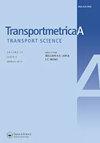The optimal solution to the energy-efficient train control in a multi-trains system-part 1: the algorithm design
IF 3.1
2区 工程技术
Q2 TRANSPORTATION
引用次数: 0
Abstract
When a train travels in a multi-trains system, the power flow of other trains and the track grades make up the spatial–temporal area (STA) for the train. Finding the optimal solution for the energy-efficient train control problem in STA can help reduce the net energy consumption. This paper studies the analytic method to obtain the optimal solution. In Part 1, we propose an algorithm specifically designed for this problem. The underlying structure of the algorithm is the connection between three optimal states through the optimal feasible strategy. We propose an algebraic method to calculate the optimal feasible strategy and discuss how it intersects with the speed limit. In Part 2, we will discuss the optimality and uniqueness of the optimal feasible strategy. Case studies using data from a real freight railway line are given to demonstrate the effectiveness of the proposed algorithm.
多列车系统中节能列车控制的最优解——算法设计
当列车在多列车系统中运行时,其他列车的功率流和轨道等级构成了列车的时空区域(STA)。寻找列车节能控制问题的最优解有助于降低净能耗。本文研究了求最优解的解析方法。在第1部分中,我们提出了一个专门针对这个问题设计的算法。该算法的底层结构是通过最优可行策略将三种最优状态连接起来。我们提出了一种计算最优可行策略的代数方法,并讨论了最优可行策略如何与限速相交。在第二部分中,我们将讨论最优可行策略的最优性和唯一性。最后以实际货运铁路的数据为例,验证了该算法的有效性。
本文章由计算机程序翻译,如有差异,请以英文原文为准。
求助全文
约1分钟内获得全文
求助全文
来源期刊

Transportmetrica A-Transport Science
TRANSPORTATION SCIENCE & TECHNOLOGY-
CiteScore
8.10
自引率
12.10%
发文量
55
期刊介绍:
Transportmetrica A provides a forum for original discourse in transport science. The international journal''s focus is on the scientific approach to transport research methodology and empirical analysis of moving people and goods. Papers related to all aspects of transportation are welcome. A rigorous peer review that involves editor screening and anonymous refereeing for submitted articles facilitates quality output.
 求助内容:
求助内容: 应助结果提醒方式:
应助结果提醒方式:


